Headphones under £20: Which to buy?

Which budget headphones are the best?
Headphones are trendy, but the ones in the spotlight generally cost well over a hundred pounds. Many are great, but we know very well that most people don’t want to spend that much.
So we asked – what’s the best pair of headphones you can get for £20? It’s a pretty tough question, but most of the big headphone makers from AKG to Skullcandy do make pairs this cheap.
We got the lot in for a direct head-to-head comparison. We’ve been using these headphones for weeks now, ready to let you know which you should be shortlisting, whether for yourself or a Christmas present.
Five pairs, all headphones – not earphones – and all available for under £20. But which pair is the best?
Meet the headphones
AKG K44
Price: £19
Style: Over-ear studio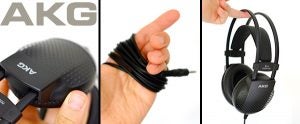
House of Marley Harambe
Price: £19.99
Style: On-ear portable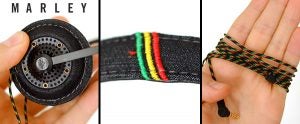
Sennheiser HD201
Price: £14.99
Style: Over-ear studio

Skullcandy Uprock
Price: £12.49
Style: On-ear portable

Sony MDR-ZX310
Price: £19.99
Style: On-ear portable

Style and Portability
You have two key choices when you go for a pair of over-the-head headphones at £20. Do you choose an on-ear pair or an over-ear set?
If you want a stylish pair, you’ll need to go for a smaller on-ear pair as you just can’t get style-driven over-ear headphones at the price. Our full-size contenders here, the Sennheiser HD201 and AKG K44, are intended more as budget monitor headphones than ones to wear out and about.
Not only will you look a bit silly wearing the huge AKG K44 out on the high street, these headphones have much longer cables than the others. With a 3m-long cable , you’ll have to keep a spool of the stuff in your pocket to avoid it dragging along the pavement. It’s do-able, but not ideal. 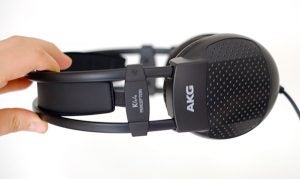
This is a particular missed opportunity in the Sennheiser HD201. They’re fairly decent-looking headphones that wouldn’t look out of place. The AKG K44 are more clearly meant for the home in their styling, with a headband structure that juts out above your near: not a great look.
What about the on-ear pairs? Here’s where you get the more deliberately provocative styles. The most eye-catching of the lot are the Skullcandy Uprock, at least in our sample.
With a pink flat cable and Skullcandy’s iconic skull logo, they’re head turners. However, they also come in some more muted shades too.
The House of Marley Harambe are similarly youth-focused, and pay an awful lot of attention to style. The backs of the ear cups and the headband are finished with fabric rather than the bare plastic used in every other pair of headphones here.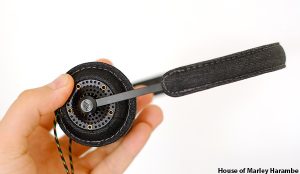
They also use the most convincing fake leather ear pads of all the headphones here, and are by far the smallest set on test. We took a look at the fairly muted black version of the Harambe headphones, but there are some brighter shades out there too.
The Sony MDR-ZX310 offer a nice middle ground between the stick-in-the-mud studio headphones from Sennheiser and AKG, and the style brats. They have a hint of style, but its much more reserved than the other on-ear pairs.
They are also the most portable pair out here, being the only one that folds in on itself. Despite being a fair bit bigger than the House of Marley Harambe, this makes them the easiest to stash in a bag.
Only the Sony and House of Marley headphones offer hands-free calls, the other pairs lacking the little remote housing that holds the necessary microphone.

Portability ratings:
Sony MDR-ZX310
House of Marley Harambe
Skullcandy Uprock
Sennheiser HD201
AKG K44
Comfort
To test the comfort of these headphones, we wore each pair for at least five hours. Wearing a set for just a few minutes doesn’t tell the full story.
While cheap headphones are rarely super-comfortable, they are generally all quite light, which can often stop any particularly bad comfort issues from cropping up. Sure enough, there are no headache-inducing horrors here.
Let’s start with the worst, though: the House of Marley Harambe. There’s not much wiggle to the ear cups, meaning the fit awkwardly on most ears. We struggled to get a particularly comfy fit, and they tend to put too much pressure on your upper earlobes unless you’re careful about the headband extension.
It’s a pity, because the House of Marley Harambe pads feel the highest-quality of the lot.
Next up is the Skullcandy Uprock. These are the only headphones with quite a firm grip of your head, making them the most suitable for running with.
However, some of you will find the grip too firm. They certainly don’t disappear on your head, and as the headband is all-plastic rather than having a steel backbone, stretching them out yourself is not a good idea. If you hate head-claping headphones, steer clear.
The Uprock are also the only headphones here to use fabric covered pads rather than synthetic leather ones. They are a mite scratchy, but the fabric works quite well, being a bit less tacky-feeling than low-grade fake leather.
It’s not all bad news for the Skullcandy Uprock – they’re perfect for gym and jogging sessions. Just not quite as good for all-day wear as some here.
Next up, the Sony MDR-ZX310. These on-ear headphones have a much lighter grip than the Skullcandys, making them seem instantly more comfortable. However, the quality of the pads and the synthetic leather topping them leaves plenty to be desired, and as the grip on your ears isn’t too strong, the plastic headband does rest on your head a bit more obviously.
This is the sort of comfort you can expect from real entry-level on-ear headphones: it’s perfectly fine, but not luxurious.
The over-ear headphones are a bit different to the on-ear ones in fit and comfort. Put them on and at first they feel creaky and cheap, particularly the AKG K44. The Sennheiser HD201 aren’t much better, though, and have easily the worst padding pleather here – it’s like bin liner material.
However, over-ears sets are better if you want to wear a pair all day long. As the large cups sit around your sensitive earlobes rather than on them, your won’t get sore ears.
The AKG K4 and Sennheiser HD201 also have proper headband padding, something missing from the other sets.
In concert with the cabling issue, this means:
Want a set for at-home use? Think about the AKGs or Sennheisers. For the gym? The Skullcandy Uprock will do the trick. The Sonys, on the other hand, are best for the commute.
Comfort ratings:
![]()
Sennheiser HD201
Sony MDR-ZX310
AKG K44
Skullcandy Uprock
House of Marley Harambe
Efficiency (loudness)
When dealing with portable headphones in particular, one issue not often discussed is how loud they are – this is also known as efficiency. It essentially tells you how high you’ll have to ramp-up your phone/MP3 player’s volume. We found that all these pairs can be drive fairly well using an iPod or phone, but there is significant variance. And it may not be what you expect.
Here’s how the run-down goes, from ‘loudest’ to quietest:
AKG K44
Skullcandy Uprock
House of Marley Harambe
Sennheiser HD201
Sony MDR-ZX310
The top four are all roughly comparable, but the Sony MDR-ZX310 is significantly quieter than the others. If you find volume from your music playing gadget an issue, think twice before buying.
Noise isolation and leakage
Blocking out the outside world and keeping your tunes from leaking out is an important role of any pair of portable headphones. All of these sets use a closed design, meaning that people around you won’t be able to hear what you’re listening to unless you really crank up the volume.
Isolation is a little more complicated, though. It’s determined by lots of factors, including the internal structure, how well the pads sit on your ears and how well their sound can compete with external noise.
The weakest of the lot are the AKG K44 and the House of Marley Harambe. Both often fail to really make a good seal with your ear, meaning it’s pretty easy for those sound waves to make their way in.
Add the limited isolation to the oversized look and the long cable and you can only conclude the AKG K44 have very little portable headphone cred.
Of the other three, the Sony MDR-Z310 is the next weakest. It makes a reasonable seal, but still lets in some noise.
The Sennheiser HD201 has the best natural isolation, but in real-life use some of you may find that the Skullcandy Uprock provides the best results. While its base level of isolation isn’t superb (it’s not amazing in any of these sets), the headphones’ thick, powerful sound that’s good at combating external noise.
![]()
Skullcandy Uprock
Sennnheiser HD201
Sony MDR-ZX310
AKG K44
House of Marley Harambe
Sound quality and clarity
As the most important section in this comparison, we’re going to give you a quick overview of these headphones’ sound signatures before looking at what they sound like in a bit more detail.
Headphone yearbook:
![]()
Sennheiser HD201:
Good clarity, fairly open sound, a bit harsh at times
AKG K44:
Good clarity, resonant, forward mid-range, a bit of extra bass
Sony MDR-ZX310:
Reasonable balance with bass skew
Skullcandy Uprock
Big bass, conservative treble
House of Marley Harambe
Beefy bottom-end, muffled mids and treble
![]()
Here’s some more impressions on the sound of these headphones.
AKG K44
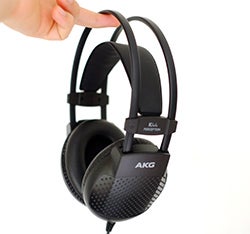 The AKG K44 are a big more cleaner-sounding than the on-ear headphones on test, with nice and clear treble and a fairly clear mid-range/bass compared with the bassier pairs.
The AKG K44 are a big more cleaner-sounding than the on-ear headphones on test, with nice and clear treble and a fairly clear mid-range/bass compared with the bassier pairs.
Low and sub-bass is fairly strong, though, only surpassed by the very bass-centric Skullcandy Uprock. When you describe them, the AKG K44 come across pretty well. Clarity plus a bass kick when needed.
However, there’s an unnatural tone to the upper-mids and a resonance in this area that we found quite trying. Upper-mid resonances make vocals sound a bit unnatural, and a bit hard on the ears at times.
House of Marley Harambe
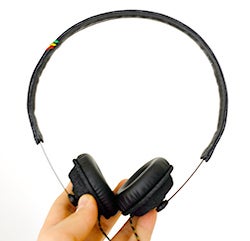 Like Skullcandy, House of Marley is a brand known for its bassy headphones, and unfortunately the Harambe pair is the worst affected by this style.
Like Skullcandy, House of Marley is a brand known for its bassy headphones, and unfortunately the Harambe pair is the worst affected by this style.
They’re thick and powerful-sounding, but the mid-range is quite congested, the soundstage is relatively narrow and treble clarity is not very good. It’s a typical example of the sorts of issues we have with headphones that use an ill-controlled bass skew.
Vocals sound quite muffled and arrangements often come across as quite confused. Despite being originally sold at a much higher price than £20, we find the Harambe to be, unfortunately, the weakest pair on test.
Sony MDR-ZX310
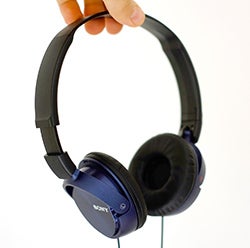 Just as the design of the Sony MDR-ZX310 places it somewhere between the studio-style Sennheisers and the boisterous Skullcandy Uprock. They have the thick, warm sound you get in most style headphones, but with a slightly less marked bass emphasis than the House of Marley and Skullcandy pairs.
Just as the design of the Sony MDR-ZX310 places it somewhere between the studio-style Sennheisers and the boisterous Skullcandy Uprock. They have the thick, warm sound you get in most style headphones, but with a slightly less marked bass emphasis than the House of Marley and Skullcandy pairs.
It’s a nice easygoing sound that we can imagine many people getting on with. But, as we noted in our full review, there are limitations. The bass isn’t hugely well-managed and the thickness in the mid-range limits the clarity here. It’s not close to the level of the clearer Sennheiser HD201.
However, treble clarity is still much better than the Skullcandy and House of Marley pairs, avoiding the muffling effect with vocals. If you want a warm, thick sound, the Sony MDR-ZX310 offer a good compromise at the price.
Sennheiser HD201
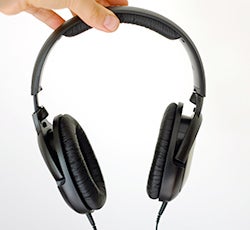 The Sennheiser HD201 are quite easily the most natural-sounding, open and expansive pair on test. Given they sell for a fair bit less than £20 in some places (at the time of writing), they are quite the bargain.
The Sennheiser HD201 are quite easily the most natural-sounding, open and expansive pair on test. Given they sell for a fair bit less than £20 in some places (at the time of writing), they are quite the bargain.
There’s none of the thickness to the sound that limits how open most of the other headphones on test sound, and they provide the most realistic portrayal of vocals. It is no wonder these headphones have been available in more-or-less the same form for the best part of a decade.
They are not perfect, though. The treble can seem a little harsh at times, and the mids and treble aren’t terribly refined. This improves as the headphones are used a little, but they are generally a bit more of a challenge on the ears than, for example, the Skullcandy Uprock.
However, they do offer a fun sound signature that is also easily the clearest here.
Bass nuts may not be impressed by the mostly balanced signature (some will call it bass-light), but give it electronic music and it can supply the necessary low-end frequencies with at least a little punch.
Skullcandy Uprock
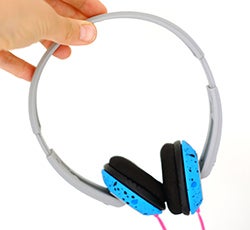 Where Beats by Dr Dre is the best-known ‘high-end’ bass brand, Skullcandy is best-known entry-level one. True to form, the Skullcandy Uprock offer powerful, bassy sound that provides a good hefty thump to kick drums.
Where Beats by Dr Dre is the best-known ‘high-end’ bass brand, Skullcandy is best-known entry-level one. True to form, the Skullcandy Uprock offer powerful, bassy sound that provides a good hefty thump to kick drums.
However, rather like the House of Marley Harambe, the Uprock lack the mid-range and treble clarity you get with the Sennheiser and AKG pairs, and to a lesser extent the Sony MDR-ZX310.
The muffling effect is not quite as bad as it is in the Harambe, but it is there. The payoff is that the sound is quite muscular and exciting for beat-based music if your ears aren’t too pedantic about other aspects of the sound. In other words, the bass is big and powerful, but muddy too.
Bass thump award
But which headphones offer the most pounding, insistent bass? If we ignore how well integrated it is and whether it’s good-quality stuff, the Skullcandy Uprock is the clear winner.
As well as offering the clearest, most powerful bass emphasis, it also accentuates low or sub bass more than any of the other pairs.
For a bass emphasis that’s well integrated, though, the AKG K44 are probably the best of the lot.
Which is the best pair of headphones?
Unfortunately there’s no 100 per cent clear answer on which headphones to buy if you have £20 to spend. For sound, we think the Sennhesier HD201 are the winners, but they have a very long, potentially impractical, cable and no remote.
If that’s not problem, go for those.
If you need headphones with a shorter cable, our top pick goes to the Sony MDR-ZX310. While their sound isn’t perfect, the mix of good styling, fair comfort and great portability make them a great buy for under £20.
MORE: Best Headphones to buy


